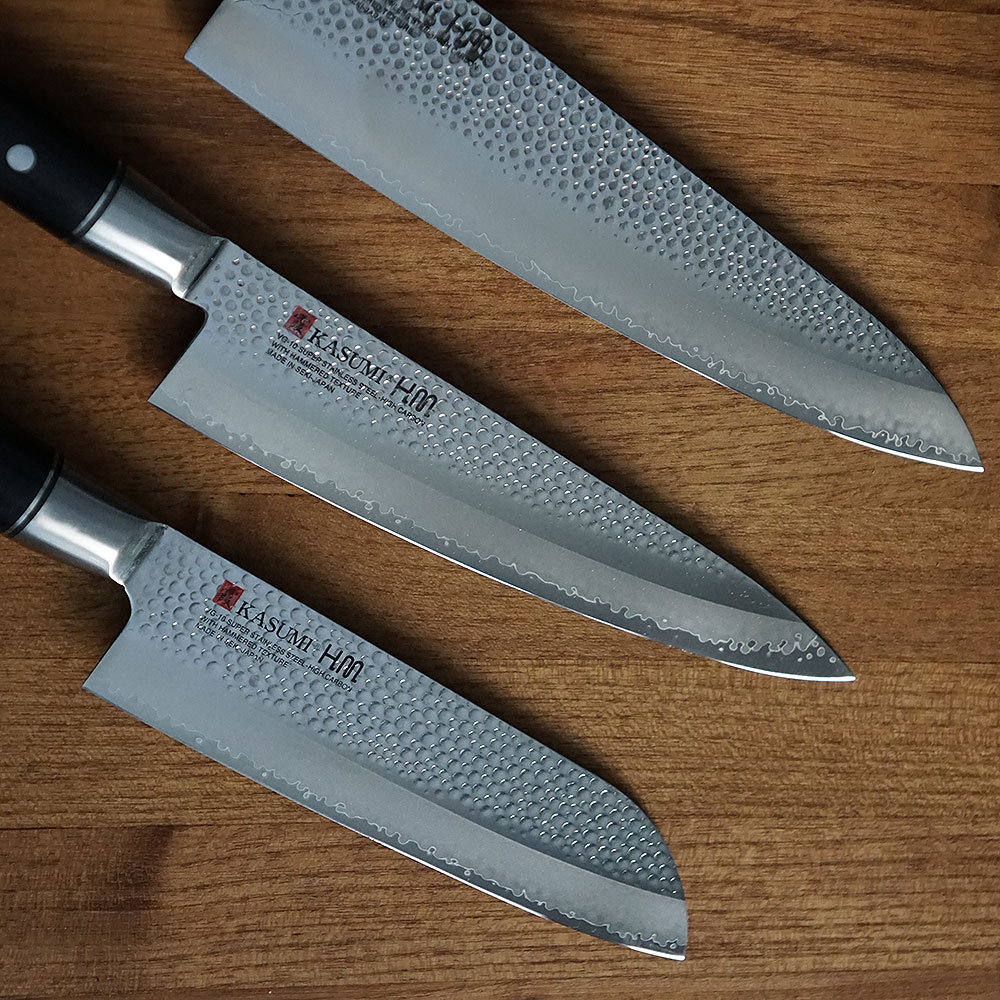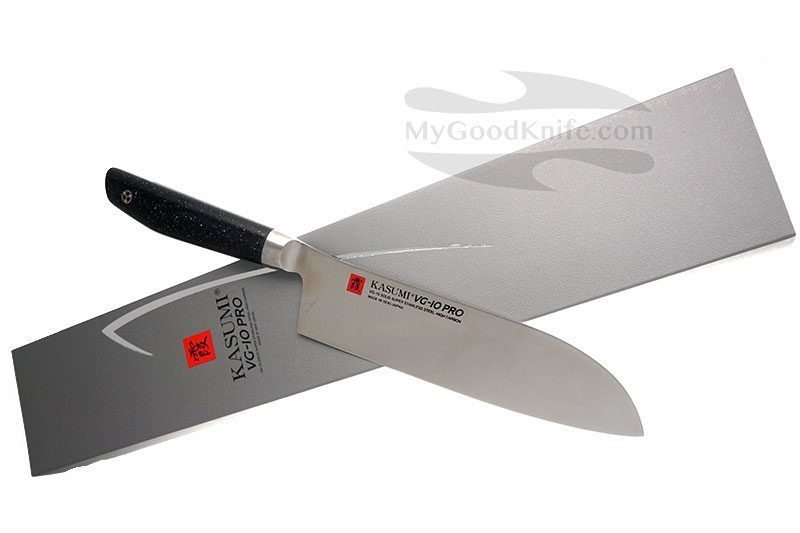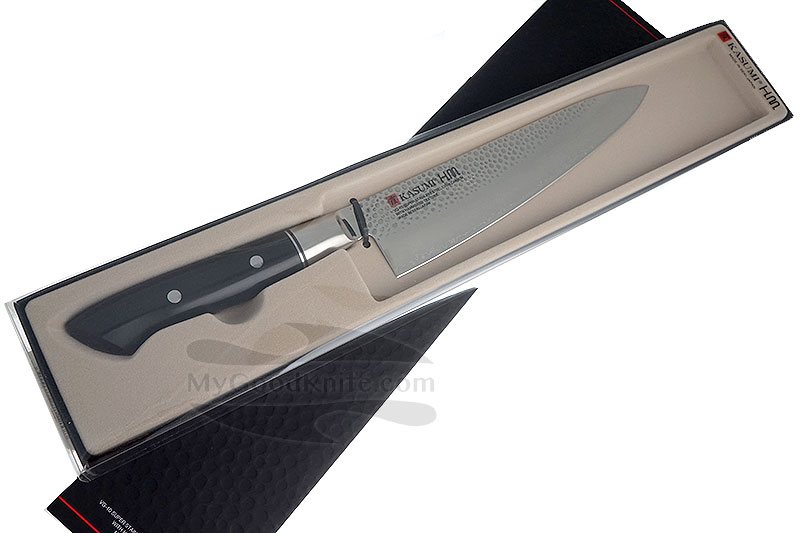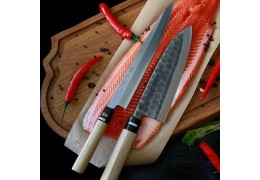We are very proud to inform, that MyGoodKnife became an official dealer of Kasumi knives (SUMIKAMA Cutlery) in Finland and Estonia.
Since 1916, SUMIKAMA has been devoted to manufacturing high-quality and value-added cutlery using the over 780-year traditions of Seki swordsmiths and its outstanding skill to harmonize new technologies with new materials.
Entering to the world market only in 1990-ies, company have managed to stand on a par and even became more successful than many of the famous manufacturers of knives from the Japanese city of Seki.
The Gifu Seki Cutlery Industry Association comprises of 53 companies in and around Seki. The cutlery industry in Seki is characterized as its multi-product and small-lot production, by which various new products based on the combination of traditional craftsmanship and modern taste are produced.
The origin of the Seki cutlery industry dates back to the 13th century, when Motoshige, a master swordsmith from the Kyushu region moved to live in the area. A lot of master swordsmiths appeared after Motoshige. However, when peace time came in the late 17th century, sword demand fell and some swordsmiths turned to blacksmiths making agricultural tools, such as knives and sickles.
Now kitchen knives (50% of domestic share), pocket knives are produced in this area and exported to Europe and the US. Seki is now recognized as a cutlery town comparable to Solingen in Germany. The recent trend of Japanese food outside Japan, especially in Western countries, is on the side of the popularity of Seki cutlery.
For sure, it is very difficult to survive and even stand out in such competition in Seki. But Sumikama company have done it. Their way can’t be called easy, however, as the way of any real Japanese warrior. Company Sumikama was founded in 1916, but knives Kasumi became famous only in the late 1990s. Today Kasumi knives is the symbol of best Japanese quality. When we talk about high-end professional chef's knives from Japan, the first name that comes to mind - is Kasumi. Perhaps the secret of company, that Kasumi offers to western customers not only a long tradition of production of Japanese knives, but absolutely modern technology and materials. Almost all of the series Kasumi are made from VG10 steel.
MyGoodKnife store would like to represent you beautiful
Kasumi HM series.
The super hard alloy VG-10 is used as a core material of the blade. This knife has a three-layered structure that holds the core material with corrosion-resistant stainless steel from both sides.
The middle layer that forms the cutting edge, called Hagane. Two layers those cover and protect hard cutting edge are called Jigane. Exсept protect role, they are also make whole blade more flexible. In general, whole this "sandwich" of three layers called Warikomi. Traditional Japanese kitchen knives are forged from two layers and have only one sharp side (like for example sushi-knives). So only one side should be protected by more flexible layer. Interesting, that this "sandwich" of two layers get name Kasumi. In English “Kasumi” means "mist". And when you look to part of blade where Hagone and Jigane are join to each other – it is really looks like beautiful swirls of mist.

Hammered Series knives pattern are hammered with many tiny indentation creates air pockets when cutting to prevent food from sticking. Hammer pattern on both sides of the blade is a result of hot forging by 300 tons of a flection machine which makes the steel stronger hammer design clear. Special tempering of the VG10 blade core create an edge retention that far surpasses other brands of similar kitchen knife. The handle is made in POM, material that makes it comfortable, resistant, hygienic and long lasting.

In
MyGoodKnife store you can find most popular
Kasumi HM knives. Every model will be useful as for professional chef as for kitchen amateur. So, in our range there are:
-
Kasumi HM Paring knife, 9 cm. This knife is traditionally used for cleaning and cutting vegetables and fruits. The handle length is 11 cm.
-
Kasumi HM Utility knife 12 cm. This knife in the English usually called a Petty knife. This is one of favorite lady’s knives. Kasumi Utility knife has a short handle – 11 cm. With it’s blade of 12 cm knife can be used for almost any everyday tasks in the kitchen. Actually, that's why it is called “utility” (all-purpose) knife.
-
Kasumi HM Nakiri 17 cm.
Nakiri knife has a straight blade edge suitable for cutting all the way to the cutting board without the need for a horizontal pull or push. Nakiri does not help with cutting small bones in fish or meat, but is useful for cutting vegetables.
-
Kasumi HM Santoku 18 cm. Santoku is also called “Japanese Chef knife”. The word refers to the three cutting tasks which the knife performs well: slicing, dicing and mincing. The Santoku's blade and handle are designed to work in harmony by matching the blade's width/weight to the weight of blade tang and handle, and the original Japanese Santoku is a well-balanced knife. With the blade length of 180 mm, Santoku Kasumi HM has 130 mm handle.
-
Kasumi HM Chef knife 20 cm. Today it is the primary general-utility knife for most western cooks. Handle length is 13 cm.
-
Kasumi HM Chef knife 24 cm. Large cook knife. Perfectly balanced. This chef knife has a quit long comfortable handle - 13 cm.
The beauty of Kasumi HM pattern knives light up the kitchen and provide the best quality and performance.
The newest Kasumi series is VG10 Pro. These latest generation of
Kasumi VG10 Pro knives are forged from one single piece of Solid Super Stainless Steel High Carbon VG-10 (HRC 60~61). The beautiful ergonomic handle is made from durable marble resin in high gloss finish and comes decorated with a mosaic pin. Kasumi VG10 Pro knives are carefully finished piece by piece throughout its process by handwork of skilled craftsmen.
In
MyGoodKnife store we represent most popular models of Kasumi VG10 Pro series:

-
Kasumi VG10 Pro Peeling knife 7 cm. Small curved bladed knives for shaping, trimming and peeling vegetables. The classical turning knife as a distinctly curved blade that makes for easy turning of vegetables: that is cutting into a barrel shapes. The handle is short. Only 9 cm, so this knife is ideally fits to lady’s hand.
-
Kasumi VG10 Pro Paring knife 8 cm . It is slightly shorter than same knife from Kasumi series HM. Handle is only 95 mm.
-
Kasumi VG10 Pro Utility knife 12 cm. This version is also a little bit shorter than it’s brother from Kasumi HM series. Handle length 105 mm.
-
Kasumi VG10 Pro Nakiri 17 cm . Width of this traditional Japanese chopping knife is 45 mm. Handle length 12 cm.
-
Kasumi VG10 Pro Santoku 18 cm . Width of the blade is 45 mm, handle length 120 mm. Santoku's blade and handle are designed to work in harmony.
-
Kasumi VG10 Pro Chef knife 20 cm . Classic western chef's knife. Handle 12 cm.
-
Kasumi VG10 Pro Chef knife 24 cm . It is quite big, great multi-tasking cook’s knife. Length of handle is 12 sm.
-
Kasumi VG10 Pro Slicer 24 cm . A knife used to cut slices of cooked or smoked meat, poultry and fish. The blade on a Slicing knife is long and thin.
All
Kasumi knives are made in western-style and have bilateral cutting edge. In Kasumi series HM and VG10 Pro there are no sushi-knives. So if you are looking for
traditional Japanese knives (with the single-edged blade) like sushi-knives, you can find them in
Tojiro and
Seki Kanetsugu collections.
The handles of
Kasumi knives are quite long, and should be comfortable even in a large cook’s hand. The knives are perfectly balanced. All handles are not slippery and very ergonomic. You will really enjoy holding Kasumi knife. Please, remember, that all
Kasumi knives are not just sharp, but Very sharp. When you work with them, be careful. However, because of this sharpness it is incredible easy to work with such knives.
Kasumi manufacture recommends using
whetstones to keep the edges razor sharp. If your knife edge is in bad condition, start sharpening with the #240-300 rough grit of the whetstones. If your knife is in average condition, start with the #1000 medium grit of the whetstones. These two grits will keep your Kasumi knives sharp enough for normal home use.
To give your knives a professional razor sharp finish, you will also need to use fine whetstone. After sharpening your knives with the #240 and/or #1000 grit, proceed with the #3000 fine grit. After that you could proceed with #8000 grit. The #8000 grit has been specially developed for super finishing knives. The #8000 grit is almost the same grit and quality like natural whetstones used to sharpen Japanese Samurai swords. You can find required
whetstones in range of Mygoodknife.
All Kasumi knives have a nice individual package.

Please remember, that
Kasumi knives should not be washed in dishwasher, and wash with ordinary neutral detergent or just water by hand. Then wipe with soft towel to maintain the best condition and for longer use.
The blades have a hardness Rockwell HRC 59-60 representing the ideal hardness for kitchen professional knives of high quality and guaranteeing the best cutting and tight performances of the cutting-edge and having a longer duration with respect to the major part of other knives.
Kasumi knives are produced by small-scale. Each knife goes through several stages of sharpening and finishing by blacksmith’s hands. Such a tradition of manufacturing swords and knives in Japan, during the long processes, the master, of course, gives the knife a part of himself. People in Japan believe, that through such way of production, knife gets a soul and becomes an extension of the hand of a warrior... or a Chef.
 Weihnachtsferien 23.–28.12Read more
Weihnachtsferien 23.–28.12Read more Paracord: Was ist das und wofür wird es verwendetRead more
Paracord: Was ist das und wofür wird es verwendetRead more Kann man Messer verschenken: Aberglaube und Regeln beim VerschenkenRead more
Kann man Messer verschenken: Aberglaube und Regeln beim VerschenkenRead more Wie man japanische Messer schärft – der vollständige Pflege- und WartungsleitfadenRead more
Wie man japanische Messer schärft – der vollständige Pflege- und WartungsleitfadenRead more Lieferungen in die USARead more
Lieferungen in die USARead more
 Hammered Series knives pattern are hammered with many tiny indentation creates air pockets when cutting to prevent food from sticking. Hammer pattern on both sides of the blade is a result of hot forging by 300 tons of a flection machine which makes the steel stronger hammer design clear. Special tempering of the VG10 blade core create an edge retention that far surpasses other brands of similar kitchen knife. The handle is made in POM, material that makes it comfortable, resistant, hygienic and long lasting.
Hammered Series knives pattern are hammered with many tiny indentation creates air pockets when cutting to prevent food from sticking. Hammer pattern on both sides of the blade is a result of hot forging by 300 tons of a flection machine which makes the steel stronger hammer design clear. Special tempering of the VG10 blade core create an edge retention that far surpasses other brands of similar kitchen knife. The handle is made in POM, material that makes it comfortable, resistant, hygienic and long lasting.
 In
In  -
-  Please remember, that
Please remember, that